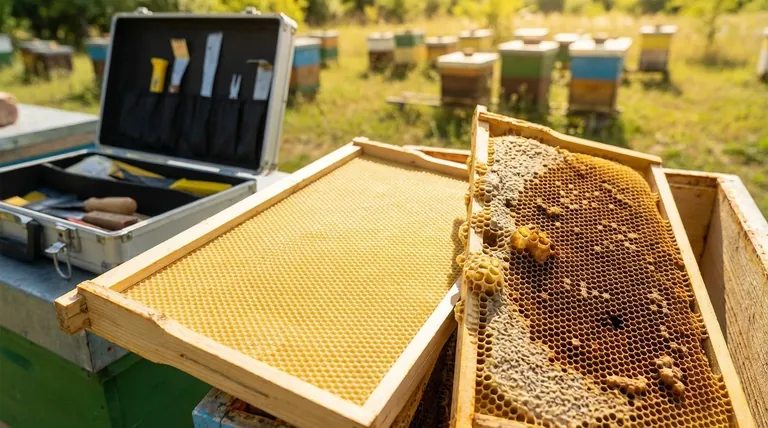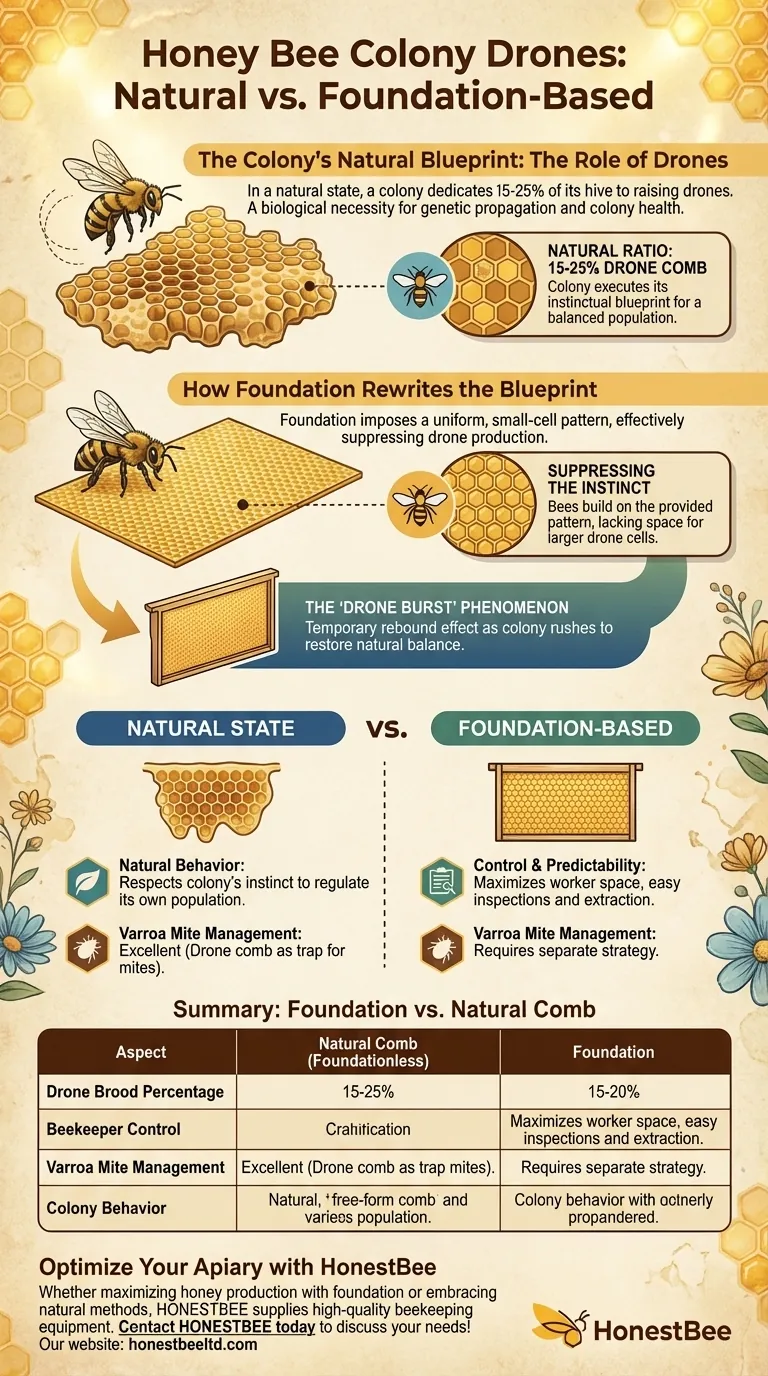In a natural state, a honey bee colony will dedicate a significant portion of its hive, typically between 15% and 25%, to raising drones. The use of commercial foundation fundamentally alters this behavior by imposing a uniform, small-cell pattern that effectively suppresses the colony's ability to produce the larger cells required for drone brood.
The choice between using foundation and going foundationless is a decision between control and biology. While foundation maximizes space for worker bees, it actively suppresses the colony's natural instinct to raise drones, which can lead to compensatory behaviors when that control is removed.

The Colony's Natural Blueprint: The Role of Drones
To understand the impact of foundation, we must first understand why bees produce drones. Drones are not a burden; they are a biological necessity and an indicator of colony health.
Why Bees Invest in Drones
The primary function of drones is to mate with virgin queens from other colonies, thereby spreading the hive's genetics. A colony that is strong, healthy, and has abundant resources will invest heavily in drone production. It is a sign of success and a strategy for long-term genetic propagation.
The Natural Ratio: 15-25% Drone Comb
Left to their own devices on natural comb or in a foundationless frame, bees will construct a mix of cell sizes. A significant portion of this comb, often 15-25%, will consist of larger cells specifically for raising drones. This is not a mistake; it is the colony executing its natural, instinctual blueprint for a balanced population.
How Foundation Rewrites the Blueprint
Foundation is a sheet of beeswax or plastic imprinted with the hexagonal pattern of worker-sized cells. Its purpose is to guide bees to build straight, uniform comb, but this has a profound biological side effect.
The Constraint of Uniform Cells
The cell pattern on standard foundation is too small to raise drones. Bees are highly efficient and will not fight the guide they are given. They build upon the provided pattern, creating walls for cells that can only accommodate worker bees or honey storage.
Suppressing the Drone-Rearing Instinct
By installing foundation throughout the brood nest, a beekeeper effectively prevents the colony from meeting its instinctual quota for drone production. The bees have the drive to create drones but lack the physical space and proper cell structure to do so.
The "Drone Burst" Phenomenon
When a colony that has been on foundation is given foundationless frames, beekeepers often witness a "drone burst." The bees, finally free from the constraint of small-cell foundation, rapidly build a large amount of drone comb to compensate for the previous suppression. This is a temporary rebound effect as the colony rushes to restore its natural demographic balance.
Understanding the Trade-offs
The decision to use foundation is not just about comb structure; it's about beekeeping philosophy and colony management.
The Argument for Foundation: Control and Predictability
Foundation provides beekeepers with perfectly straight combs that are easy to inspect and extract honey from. By limiting drone production, it theoretically maximizes the number of worker bees, which are the primary foragers and honey producers.
The Argument for Foundationless: Natural Behavior
Allowing bees to build their own comb respects their natural instincts. It lets the colony regulate its own population and decide for itself how many drones it needs based on its health and resources. This is a core principle of "natural beekeeping."
A Critical Insight: Varroa Mite Management
Varroa mites, a devastating parasite, have a strong preference for reproducing in drone brood due to its longer capped period. Beekeepers can turn this preference into a powerful pest management tool. By intentionally providing a foundationless frame (a "drone frame"), you encourage bees to build drone comb, which acts as a trap for the mites. Once the drone cells are capped, the entire frame can be removed and frozen to kill the mites within, drastically reducing the hive's parasite load without chemicals.
Making the Right Choice for Your Apiary
Your decision should align with your specific goals as a beekeeper. There is no single "correct" answer, only the best approach for your management style.
- If your primary focus is maximizing honey yield and ensuring easy inspections: Using foundation provides the control and predictability needed to achieve this goal.
- If your primary focus is "natural beekeeping" and integrated pest management: Going foundationless allows the colony to express its natural behaviors and enables you to use drone brood as a trap for Varroa mites.
- If you are transitioning an established colony to foundationless frames: Be prepared for an initial "drone burst" and understand it is a temporary, corrective behavior.
Ultimately, understanding the biological purpose of drones empowers you to make a more informed decision that benefits both you and your bees.
Summary Table:
| Aspect | Natural Comb (Foundationless) | Foundation |
|---|---|---|
| Drone Brood Percentage | 15-25% (Self-regulated) | Effectively Suppressed |
| Beekeeper Control | Low (Colony decides) | High (Predictable comb) |
| Varroa Mite Management | Excellent (Drone comb as trap) | Requires separate strategy |
| Colony Behavior | Natural instincts expressed | Drone-rearing instinct suppressed |
Optimize your apiary's health and productivity with the right equipment. Whether your focus is maximizing honey production with foundation or embracing natural beekeeping methods, HONESTBEE supplies commercial apiaries and distributors with the high-quality beekeeping supplies and equipment needed to succeed. Let our wholesale-focused expertise help you make the best choice for your operation. Contact HONESTBEE today to discuss your needs!
Visual Guide

Related Products
- Notebook Style Beeswax Foundation Mould Wax Foundation Mold
- Food Grade Plastic bee Foundation for Bee Frames
- Electric Flatting and Embossing Machine with Tray for Beekeeping
- Electric Beeswax Foundation Machine With Operating Tray and Wax Foundation Roller
- HONESTBEE Pneumatic Dual Wire Embedder for W-Pattern Foundation Wiring
People Also Ask
- How is beeswax foundation installed and what are its characteristics? Boost Hive Health Naturally
- What is beeswax foundation made of? A Guide to Stronger, More Efficient Hives
- What are the uses of recycled beeswax cappings? Transform Honey Byproducts into Valuable Assets
- What is the process for making beeswax sheets using a mold? A Step-by-Step Guide for Perfect Results
- How do you store beeswax foundation? Prevent Wax Moth Damage and Preserve Quality



















